Real Estate Project Budget, Tender Bidding, and Status Report Analysis
VerifiedAdded on 2023/04/24
|12
|1820
|430
Report
AI Summary
This report provides a detailed analysis of a real estate project, encompassing budget considerations, tender bidding processes, and project status reporting. It examines various budget components, including the original budget, approved revisions, change orders, committed costs, and forecasts, to assess the project's financial health and potential variances. The report also highlights the benefits of project status reporting, such as improved communication, clarity, and focus among stakeholders. Furthermore, it compares the timelines of Company B and Company C, evaluates the potential effects of funding delays, and discusses contract leveling strategies to ensure service provider accountability. The document includes a table summarizing key project tasks, timelines, and decisions, offering a comprehensive overview of the project's progress and challenges. Students can find similar solved assignments and resources on Desklib.
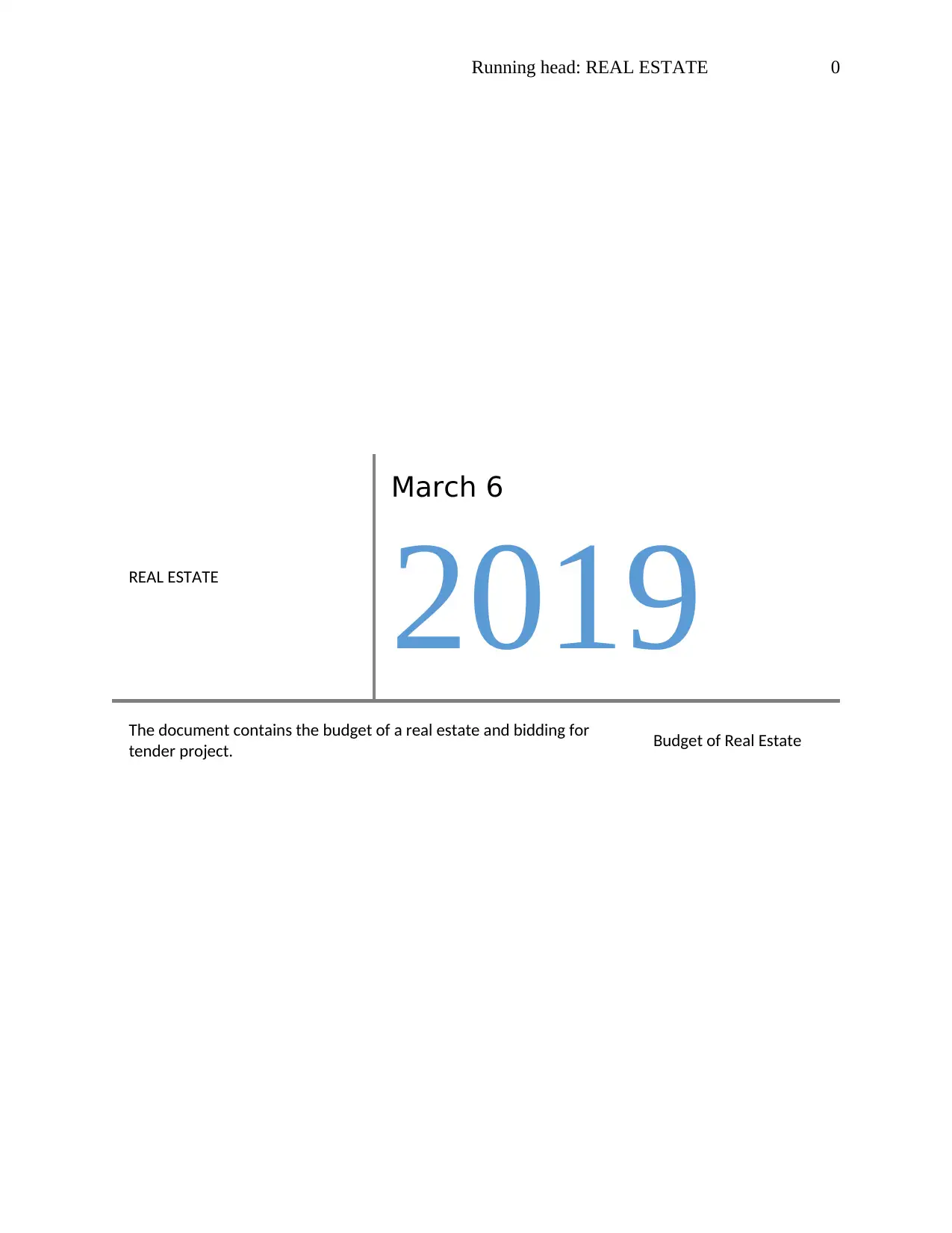
Running head: REAL ESTATE 0
REAL ESTATE
March 6
2019
The document contains the budget of a real estate and bidding for
tender project. Budget of Real Estate
REAL ESTATE
March 6
2019
The document contains the budget of a real estate and bidding for
tender project. Budget of Real Estate
Paraphrase This Document
Need a fresh take? Get an instant paraphrase of this document with our AI Paraphraser
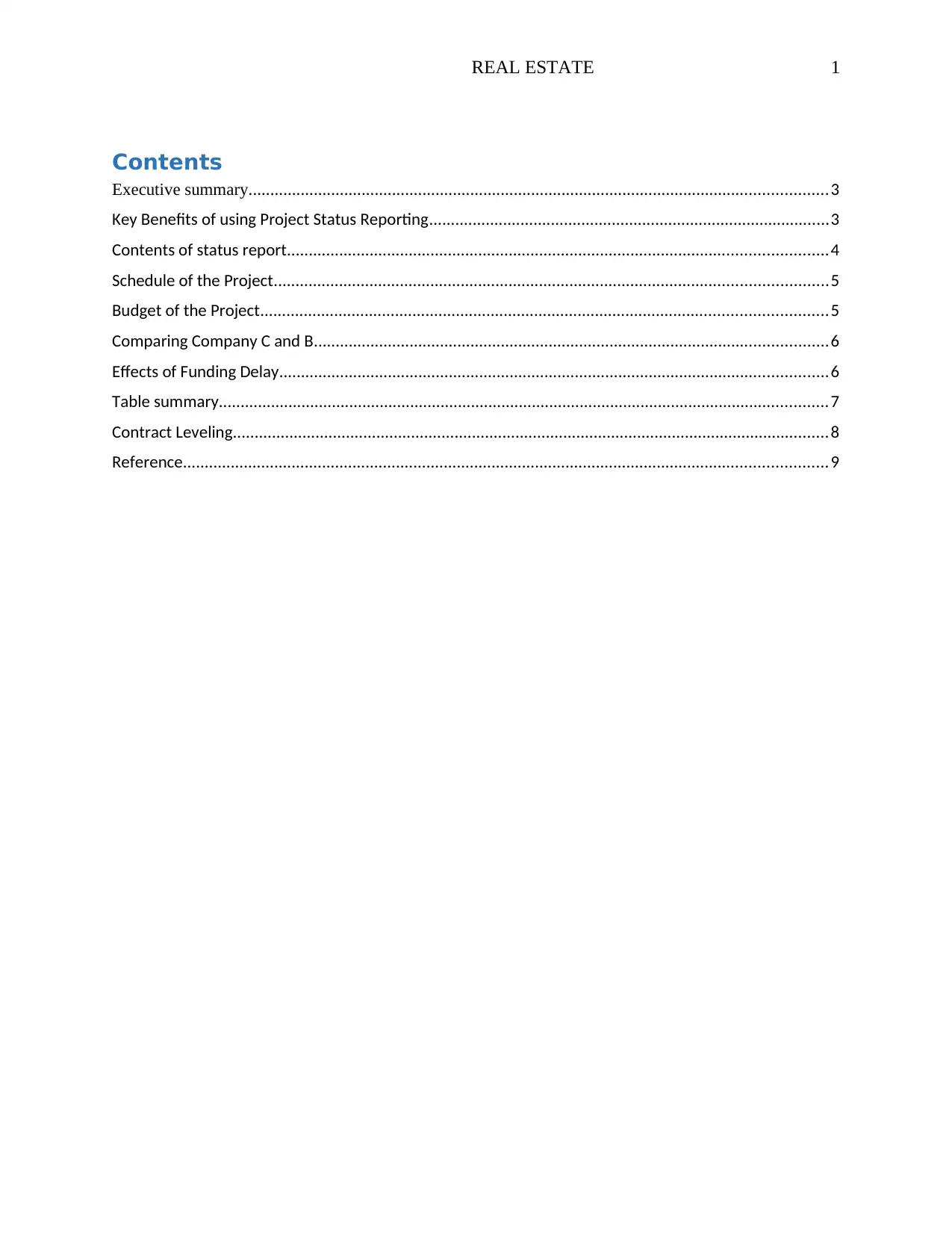
REAL ESTATE 1
Contents
Executive summary.....................................................................................................................................3
Key Benefits of using Project Status Reporting............................................................................................3
Contents of status report............................................................................................................................4
Schedule of the Project...............................................................................................................................5
Budget of the Project..................................................................................................................................5
Comparing Company C and B......................................................................................................................6
Effects of Funding Delay..............................................................................................................................6
Table summary............................................................................................................................................7
Contract Leveling.........................................................................................................................................8
Reference....................................................................................................................................................9
Contents
Executive summary.....................................................................................................................................3
Key Benefits of using Project Status Reporting............................................................................................3
Contents of status report............................................................................................................................4
Schedule of the Project...............................................................................................................................5
Budget of the Project..................................................................................................................................5
Comparing Company C and B......................................................................................................................6
Effects of Funding Delay..............................................................................................................................6
Table summary............................................................................................................................................7
Contract Leveling.........................................................................................................................................8
Reference....................................................................................................................................................9

REAL ESTATE 2
Real Estate
Student’s Name
Supervisor’s Name
Institution-Affiliated
Date
Real Estate
Student’s Name
Supervisor’s Name
Institution-Affiliated
Date
⊘ This is a preview!⊘
Do you want full access?
Subscribe today to unlock all pages.

Trusted by 1+ million students worldwide
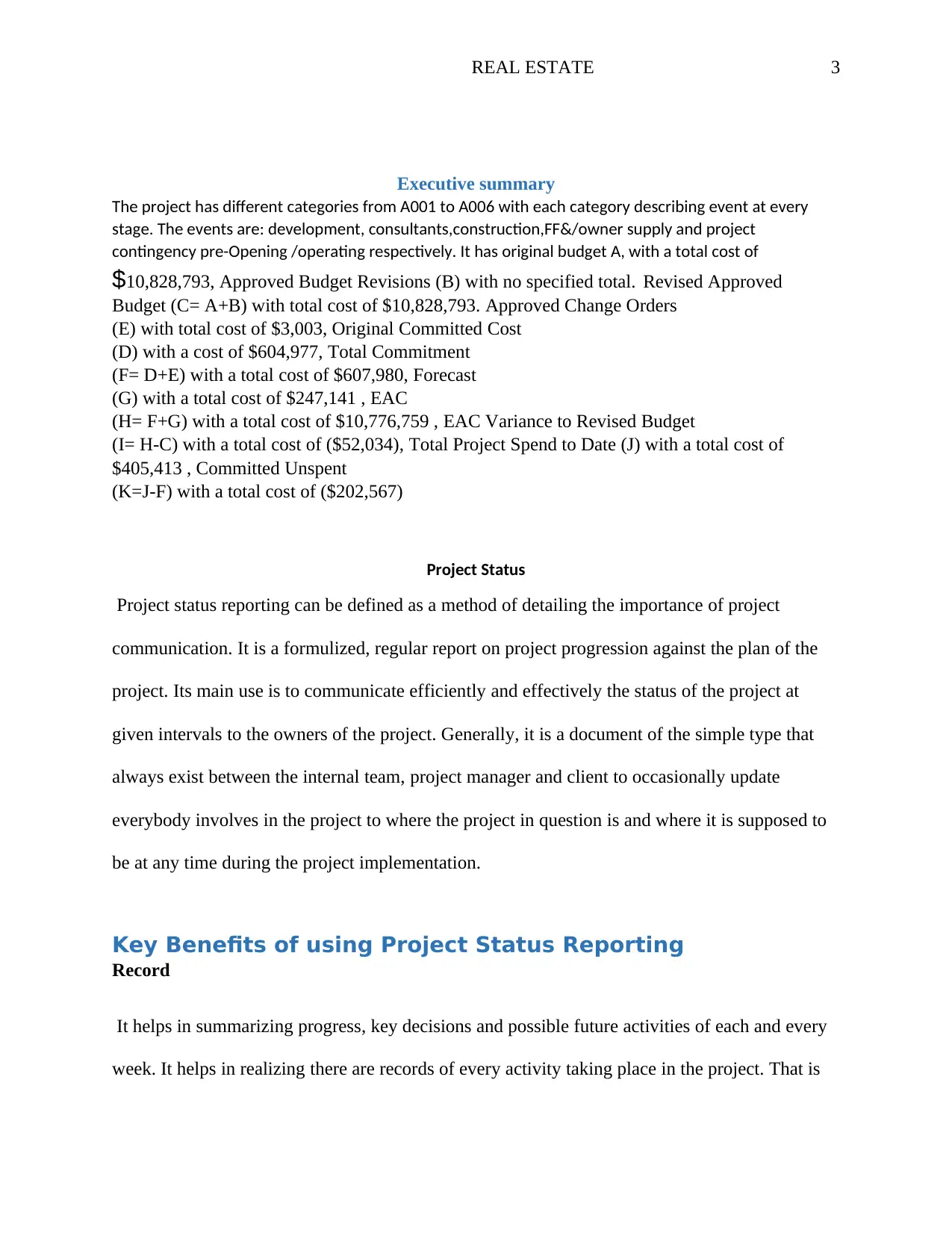
REAL ESTATE 3
Executive summary
The project has different categories from A001 to A006 with each category describing event at every
stage. The events are: development, consultants,construction,FF&/owner supply and project
contingency pre-Opening /operating respectively. It has original budget A, with a total cost of
$10,828,793, Approved Budget Revisions (B) with no specified total. Revised Approved
Budget (C= A+B) with total cost of $10,828,793. Approved Change Orders
(E) with total cost of $3,003, Original Committed Cost
(D) with a cost of $604,977, Total Commitment
(F= D+E) with a total cost of $607,980, Forecast
(G) with a total cost of $247,141 , EAC
(H= F+G) with a total cost of $10,776,759 , EAC Variance to Revised Budget
(I= H-C) with a total cost of ($52,034), Total Project Spend to Date (J) with a total cost of
$405,413 , Committed Unspent
(K=J-F) with a total cost of ($202,567)
Project Status
Project status reporting can be defined as a method of detailing the importance of project
communication. It is a formulized, regular report on project progression against the plan of the
project. Its main use is to communicate efficiently and effectively the status of the project at
given intervals to the owners of the project. Generally, it is a document of the simple type that
always exist between the internal team, project manager and client to occasionally update
everybody involves in the project to where the project in question is and where it is supposed to
be at any time during the project implementation.
Key Benefits of using Project Status Reporting
Record
It helps in summarizing progress, key decisions and possible future activities of each and every
week. It helps in realizing there are records of every activity taking place in the project. That is
Executive summary
The project has different categories from A001 to A006 with each category describing event at every
stage. The events are: development, consultants,construction,FF&/owner supply and project
contingency pre-Opening /operating respectively. It has original budget A, with a total cost of
$10,828,793, Approved Budget Revisions (B) with no specified total. Revised Approved
Budget (C= A+B) with total cost of $10,828,793. Approved Change Orders
(E) with total cost of $3,003, Original Committed Cost
(D) with a cost of $604,977, Total Commitment
(F= D+E) with a total cost of $607,980, Forecast
(G) with a total cost of $247,141 , EAC
(H= F+G) with a total cost of $10,776,759 , EAC Variance to Revised Budget
(I= H-C) with a total cost of ($52,034), Total Project Spend to Date (J) with a total cost of
$405,413 , Committed Unspent
(K=J-F) with a total cost of ($202,567)
Project Status
Project status reporting can be defined as a method of detailing the importance of project
communication. It is a formulized, regular report on project progression against the plan of the
project. Its main use is to communicate efficiently and effectively the status of the project at
given intervals to the owners of the project. Generally, it is a document of the simple type that
always exist between the internal team, project manager and client to occasionally update
everybody involves in the project to where the project in question is and where it is supposed to
be at any time during the project implementation.
Key Benefits of using Project Status Reporting
Record
It helps in summarizing progress, key decisions and possible future activities of each and every
week. It helps in realizing there are records of every activity taking place in the project. That is
Paraphrase This Document
Need a fresh take? Get an instant paraphrase of this document with our AI Paraphraser
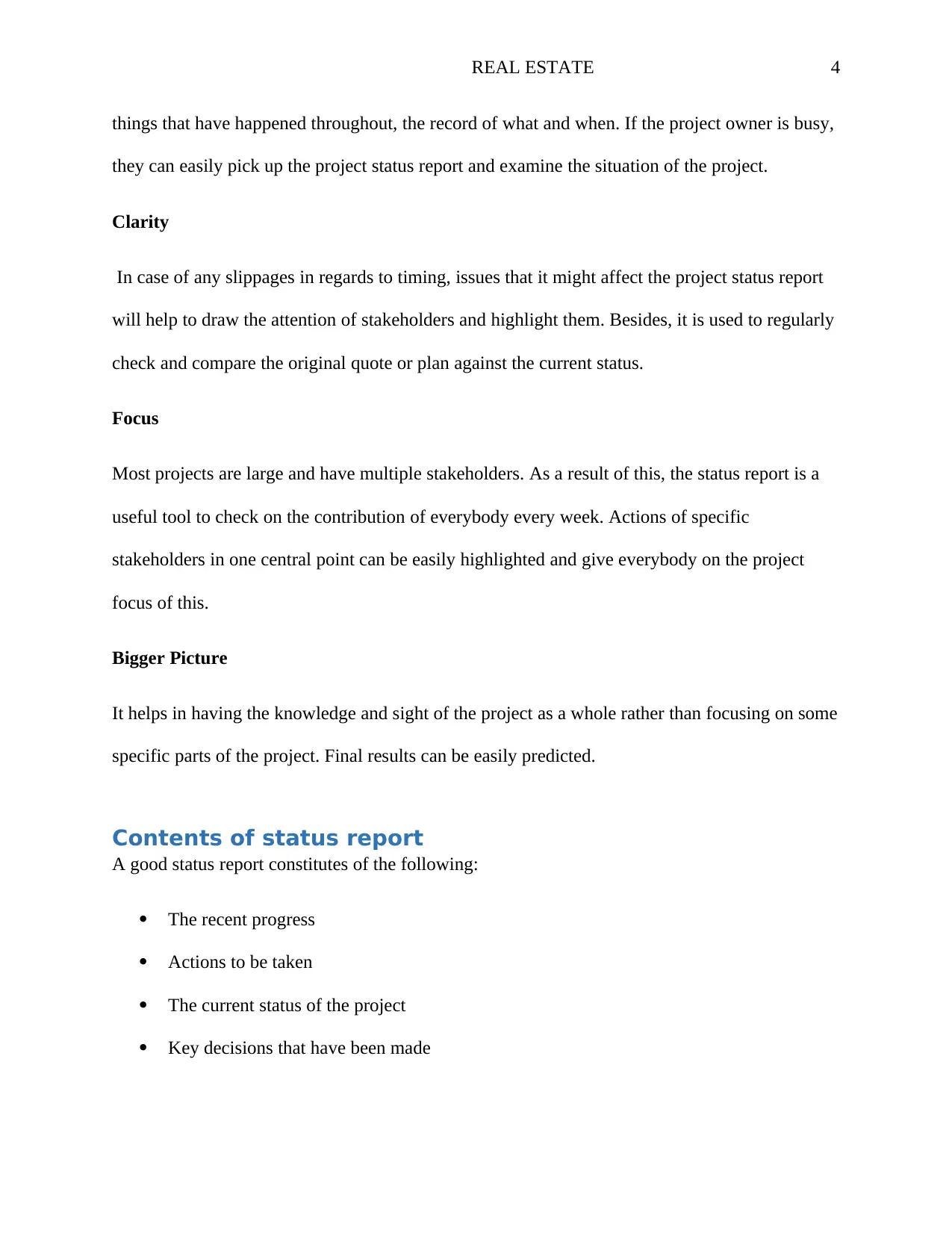
REAL ESTATE 4
things that have happened throughout, the record of what and when. If the project owner is busy,
they can easily pick up the project status report and examine the situation of the project.
Clarity
In case of any slippages in regards to timing, issues that it might affect the project status report
will help to draw the attention of stakeholders and highlight them. Besides, it is used to regularly
check and compare the original quote or plan against the current status.
Focus
Most projects are large and have multiple stakeholders. As a result of this, the status report is a
useful tool to check on the contribution of everybody every week. Actions of specific
stakeholders in one central point can be easily highlighted and give everybody on the project
focus of this.
Bigger Picture
It helps in having the knowledge and sight of the project as a whole rather than focusing on some
specific parts of the project. Final results can be easily predicted.
Contents of status report
A good status report constitutes of the following:
The recent progress
Actions to be taken
The current status of the project
Key decisions that have been made
things that have happened throughout, the record of what and when. If the project owner is busy,
they can easily pick up the project status report and examine the situation of the project.
Clarity
In case of any slippages in regards to timing, issues that it might affect the project status report
will help to draw the attention of stakeholders and highlight them. Besides, it is used to regularly
check and compare the original quote or plan against the current status.
Focus
Most projects are large and have multiple stakeholders. As a result of this, the status report is a
useful tool to check on the contribution of everybody every week. Actions of specific
stakeholders in one central point can be easily highlighted and give everybody on the project
focus of this.
Bigger Picture
It helps in having the knowledge and sight of the project as a whole rather than focusing on some
specific parts of the project. Final results can be easily predicted.
Contents of status report
A good status report constitutes of the following:
The recent progress
Actions to be taken
The current status of the project
Key decisions that have been made
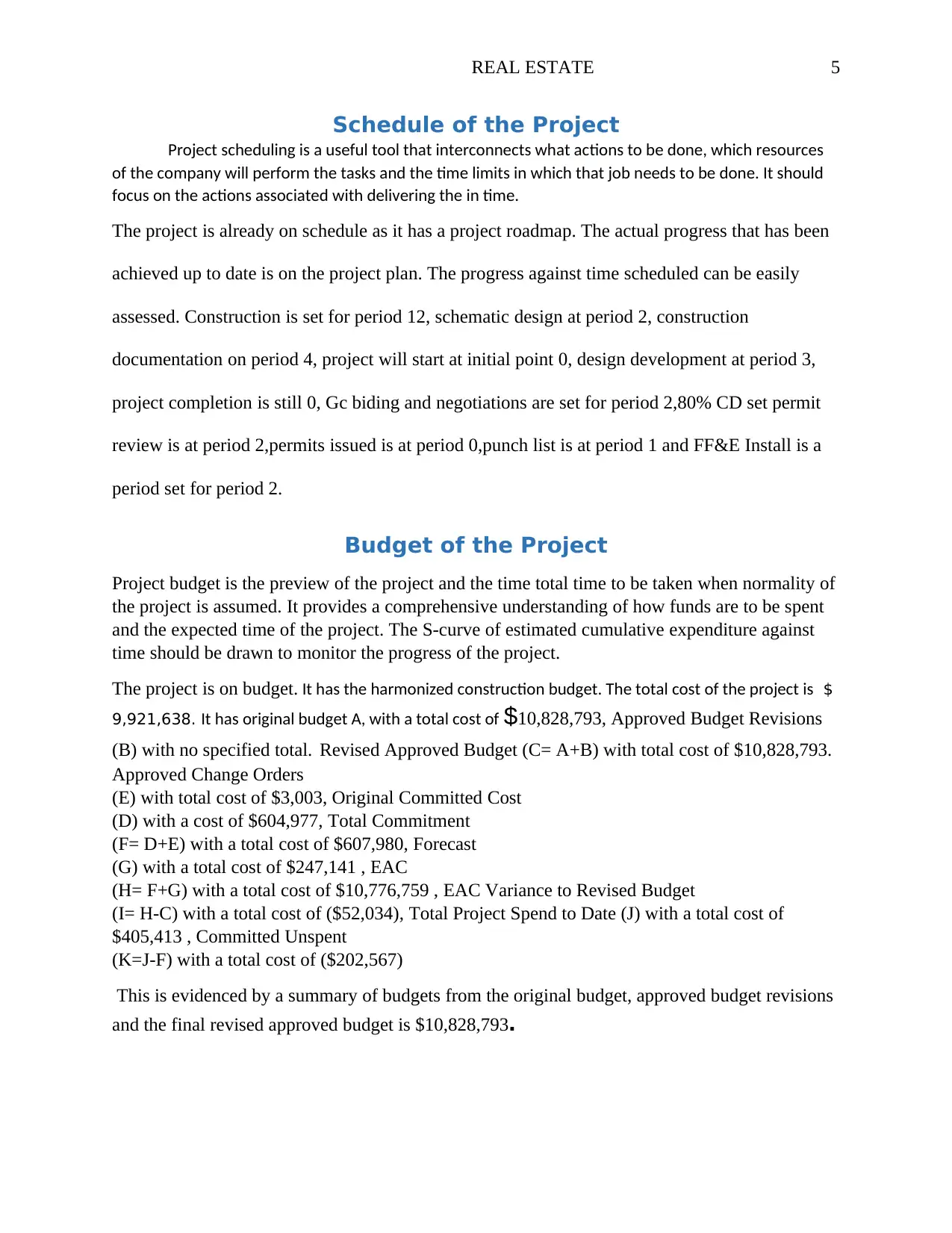
REAL ESTATE 5
Schedule of the Project
Project scheduling is a useful tool that interconnects what actions to be done, which resources
of the company will perform the tasks and the time limits in which that job needs to be done. It should
focus on the actions associated with delivering the in time.
The project is already on schedule as it has a project roadmap. The actual progress that has been
achieved up to date is on the project plan. The progress against time scheduled can be easily
assessed. Construction is set for period 12, schematic design at period 2, construction
documentation on period 4, project will start at initial point 0, design development at period 3,
project completion is still 0, Gc biding and negotiations are set for period 2,80% CD set permit
review is at period 2,permits issued is at period 0,punch list is at period 1 and FF&E Install is a
period set for period 2.
Budget of the Project
Project budget is the preview of the project and the time total time to be taken when normality of
the project is assumed. It provides a comprehensive understanding of how funds are to be spent
and the expected time of the project. The S-curve of estimated cumulative expenditure against
time should be drawn to monitor the progress of the project.
The project is on budget. It has the harmonized construction budget. The total cost of the project is $
9,921,638. It has original budget A, with a total cost of $10,828,793, Approved Budget Revisions
(B) with no specified total. Revised Approved Budget (C= A+B) with total cost of $10,828,793.
Approved Change Orders
(E) with total cost of $3,003, Original Committed Cost
(D) with a cost of $604,977, Total Commitment
(F= D+E) with a total cost of $607,980, Forecast
(G) with a total cost of $247,141 , EAC
(H= F+G) with a total cost of $10,776,759 , EAC Variance to Revised Budget
(I= H-C) with a total cost of ($52,034), Total Project Spend to Date (J) with a total cost of
$405,413 , Committed Unspent
(K=J-F) with a total cost of ($202,567)
This is evidenced by a summary of budgets from the original budget, approved budget revisions
and the final revised approved budget is $10,828,793.
Schedule of the Project
Project scheduling is a useful tool that interconnects what actions to be done, which resources
of the company will perform the tasks and the time limits in which that job needs to be done. It should
focus on the actions associated with delivering the in time.
The project is already on schedule as it has a project roadmap. The actual progress that has been
achieved up to date is on the project plan. The progress against time scheduled can be easily
assessed. Construction is set for period 12, schematic design at period 2, construction
documentation on period 4, project will start at initial point 0, design development at period 3,
project completion is still 0, Gc biding and negotiations are set for period 2,80% CD set permit
review is at period 2,permits issued is at period 0,punch list is at period 1 and FF&E Install is a
period set for period 2.
Budget of the Project
Project budget is the preview of the project and the time total time to be taken when normality of
the project is assumed. It provides a comprehensive understanding of how funds are to be spent
and the expected time of the project. The S-curve of estimated cumulative expenditure against
time should be drawn to monitor the progress of the project.
The project is on budget. It has the harmonized construction budget. The total cost of the project is $
9,921,638. It has original budget A, with a total cost of $10,828,793, Approved Budget Revisions
(B) with no specified total. Revised Approved Budget (C= A+B) with total cost of $10,828,793.
Approved Change Orders
(E) with total cost of $3,003, Original Committed Cost
(D) with a cost of $604,977, Total Commitment
(F= D+E) with a total cost of $607,980, Forecast
(G) with a total cost of $247,141 , EAC
(H= F+G) with a total cost of $10,776,759 , EAC Variance to Revised Budget
(I= H-C) with a total cost of ($52,034), Total Project Spend to Date (J) with a total cost of
$405,413 , Committed Unspent
(K=J-F) with a total cost of ($202,567)
This is evidenced by a summary of budgets from the original budget, approved budget revisions
and the final revised approved budget is $10,828,793.
⊘ This is a preview!⊘
Do you want full access?
Subscribe today to unlock all pages.

Trusted by 1+ million students worldwide
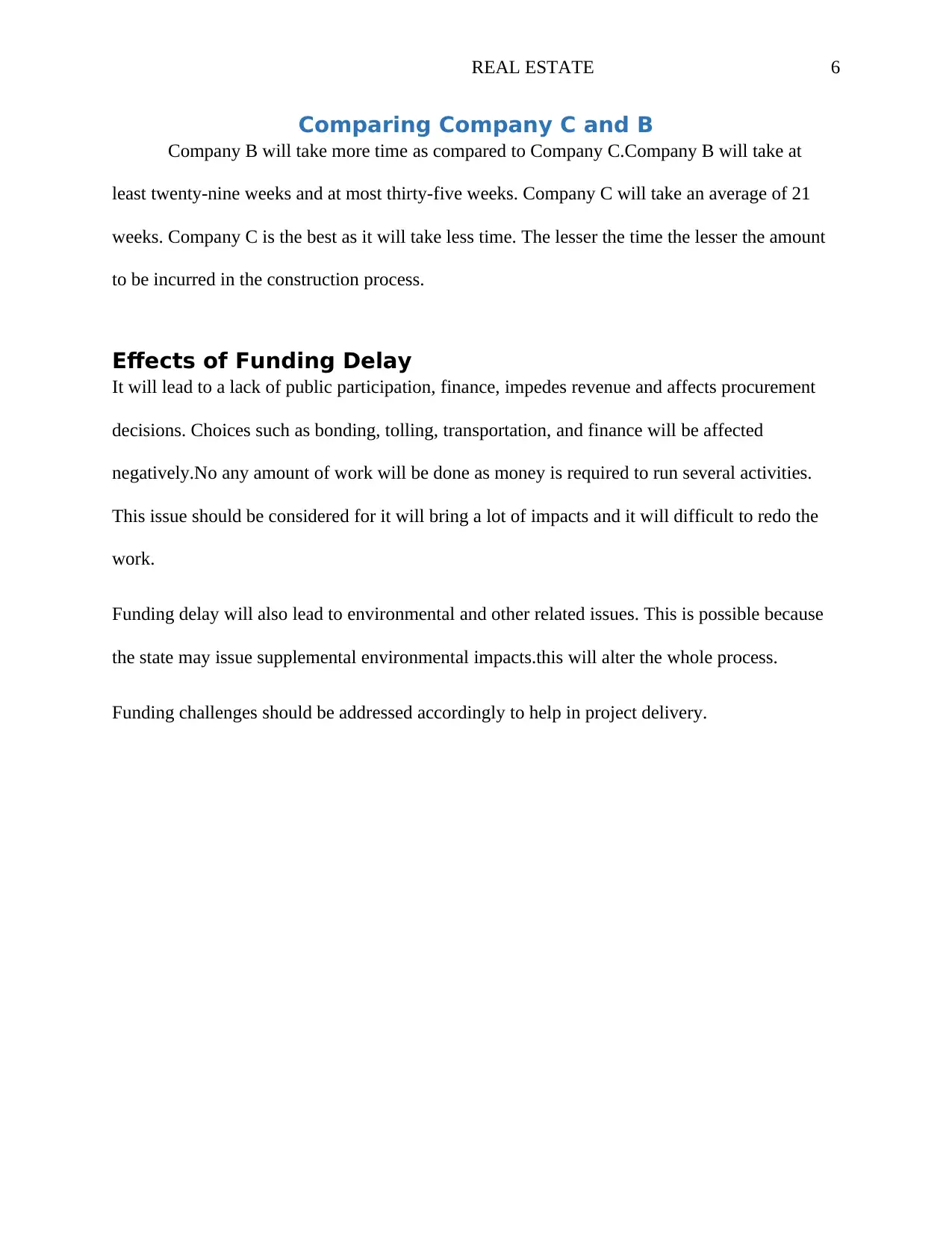
REAL ESTATE 6
Comparing Company C and B
Company B will take more time as compared to Company C.Company B will take at
least twenty-nine weeks and at most thirty-five weeks. Company C will take an average of 21
weeks. Company C is the best as it will take less time. The lesser the time the lesser the amount
to be incurred in the construction process.
Effects of Funding Delay
It will lead to a lack of public participation, finance, impedes revenue and affects procurement
decisions. Choices such as bonding, tolling, transportation, and finance will be affected
negatively.No any amount of work will be done as money is required to run several activities.
This issue should be considered for it will bring a lot of impacts and it will difficult to redo the
work.
Funding delay will also lead to environmental and other related issues. This is possible because
the state may issue supplemental environmental impacts.this will alter the whole process.
Funding challenges should be addressed accordingly to help in project delivery.
Comparing Company C and B
Company B will take more time as compared to Company C.Company B will take at
least twenty-nine weeks and at most thirty-five weeks. Company C will take an average of 21
weeks. Company C is the best as it will take less time. The lesser the time the lesser the amount
to be incurred in the construction process.
Effects of Funding Delay
It will lead to a lack of public participation, finance, impedes revenue and affects procurement
decisions. Choices such as bonding, tolling, transportation, and finance will be affected
negatively.No any amount of work will be done as money is required to run several activities.
This issue should be considered for it will bring a lot of impacts and it will difficult to redo the
work.
Funding delay will also lead to environmental and other related issues. This is possible because
the state may issue supplemental environmental impacts.this will alter the whole process.
Funding challenges should be addressed accordingly to help in project delivery.
Paraphrase This Document
Need a fresh take? Get an instant paraphrase of this document with our AI Paraphraser
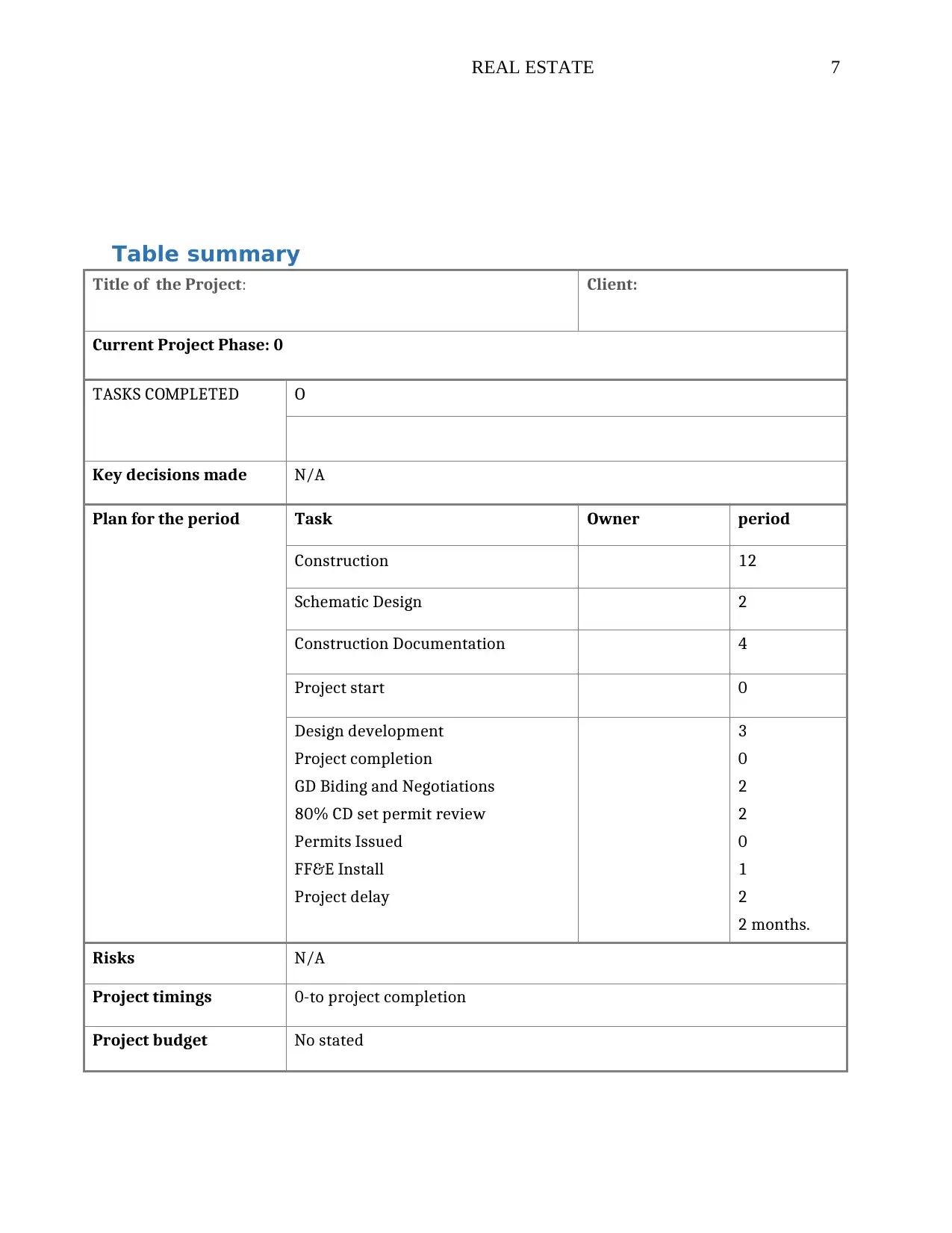
REAL ESTATE 7
Table summary
Title of the Project: Client:
Current Project Phase: 0
TASKS COMPLETED O
Key decisions made N/A
Plan for the period Task Owner period
Construction 12
Schematic Design 2
Construction Documentation 4
Project start 0
Design development
Project completion
GD Biding and Negotiations
80% CD set permit review
Permits Issued
FF&E Install
Project delay
3
0
2
2
0
1
2
2 months.
Risks N/A
Project timings 0-to project completion
Project budget No stated
Table summary
Title of the Project: Client:
Current Project Phase: 0
TASKS COMPLETED O
Key decisions made N/A
Plan for the period Task Owner period
Construction 12
Schematic Design 2
Construction Documentation 4
Project start 0
Design development
Project completion
GD Biding and Negotiations
80% CD set permit review
Permits Issued
FF&E Install
Project delay
3
0
2
2
0
1
2
2 months.
Risks N/A
Project timings 0-to project completion
Project budget No stated
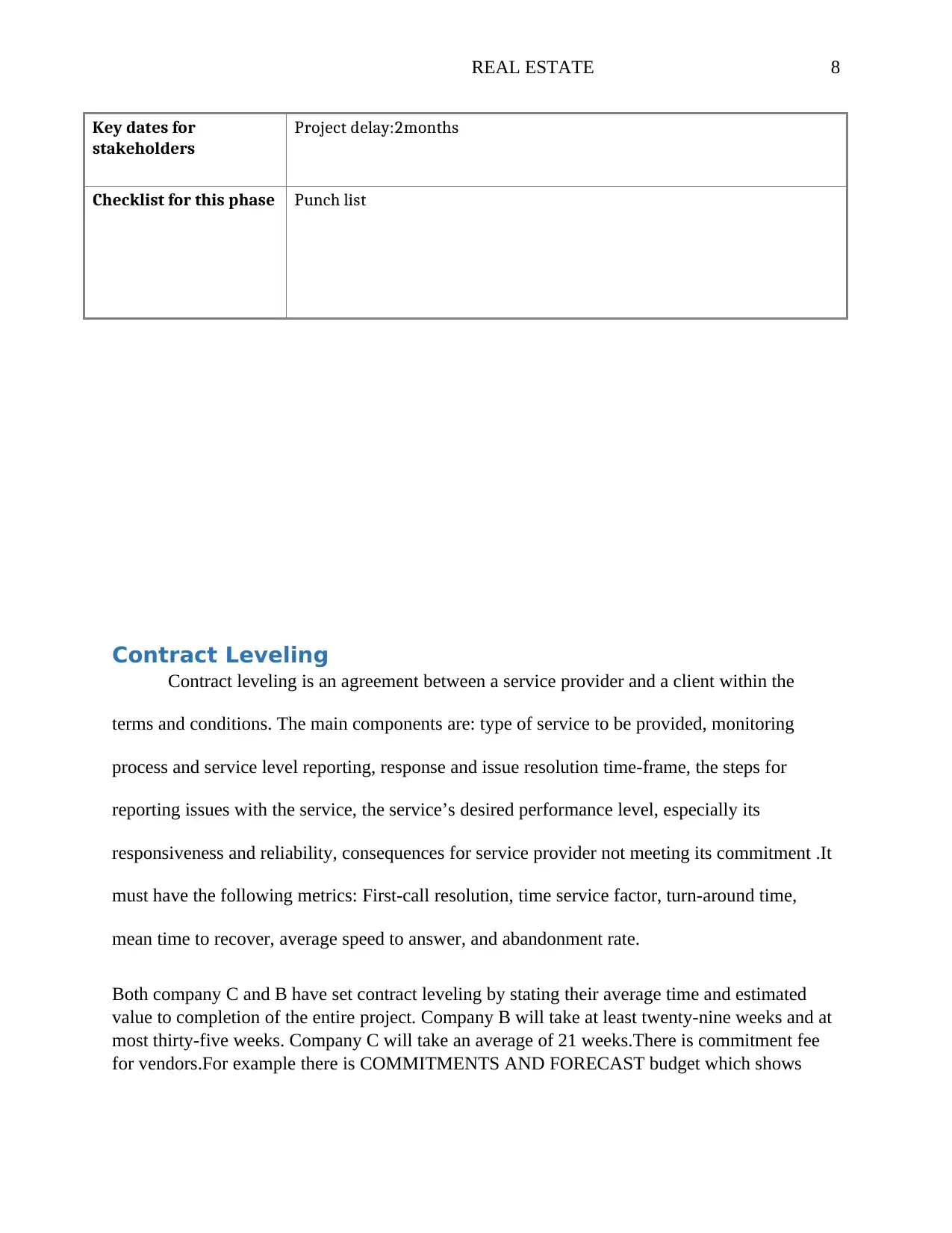
REAL ESTATE 8
Key dates for
stakeholders
Project delay:2months
Checklist for this phase Punch list
Contract Leveling
Contract leveling is an agreement between a service provider and a client within the
terms and conditions. The main components are: type of service to be provided, monitoring
process and service level reporting, response and issue resolution time-frame, the steps for
reporting issues with the service, the service’s desired performance level, especially its
responsiveness and reliability, consequences for service provider not meeting its commitment .It
must have the following metrics: First-call resolution, time service factor, turn-around time,
mean time to recover, average speed to answer, and abandonment rate.
Both company C and B have set contract leveling by stating their average time and estimated
value to completion of the entire project. Company B will take at least twenty-nine weeks and at
most thirty-five weeks. Company C will take an average of 21 weeks.There is commitment fee
for vendors.For example there is COMMITMENTS AND FORECAST budget which shows
Key dates for
stakeholders
Project delay:2months
Checklist for this phase Punch list
Contract Leveling
Contract leveling is an agreement between a service provider and a client within the
terms and conditions. The main components are: type of service to be provided, monitoring
process and service level reporting, response and issue resolution time-frame, the steps for
reporting issues with the service, the service’s desired performance level, especially its
responsiveness and reliability, consequences for service provider not meeting its commitment .It
must have the following metrics: First-call resolution, time service factor, turn-around time,
mean time to recover, average speed to answer, and abandonment rate.
Both company C and B have set contract leveling by stating their average time and estimated
value to completion of the entire project. Company B will take at least twenty-nine weeks and at
most thirty-five weeks. Company C will take an average of 21 weeks.There is commitment fee
for vendors.For example there is COMMITMENTS AND FORECAST budget which shows
⊘ This is a preview!⊘
Do you want full access?
Subscribe today to unlock all pages.

Trusted by 1+ million students worldwide

REAL ESTATE 9
what vendors will provide and the allocated commitment fee. Total Commitment
(F= D+E) of $563.
what vendors will provide and the allocated commitment fee. Total Commitment
(F= D+E) of $563.
Paraphrase This Document
Need a fresh take? Get an instant paraphrase of this document with our AI Paraphraser

REAL ESTATE 10
Reference
Reference
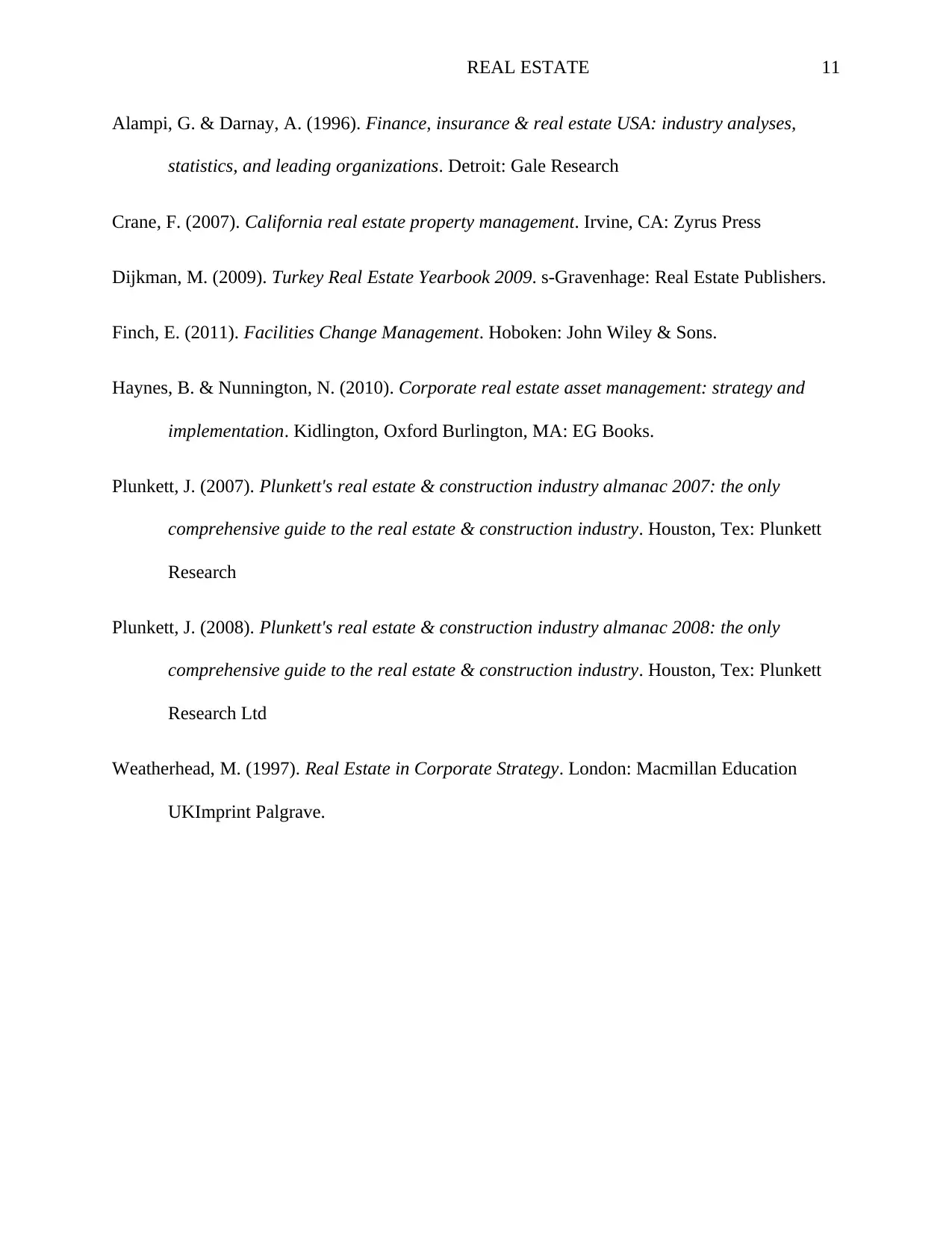
REAL ESTATE 11
Alampi, G. & Darnay, A. (1996). Finance, insurance & real estate USA: industry analyses,
statistics, and leading organizations. Detroit: Gale Research
Crane, F. (2007). California real estate property management. Irvine, CA: Zyrus Press
Dijkman, M. (2009). Turkey Real Estate Yearbook 2009. s-Gravenhage: Real Estate Publishers.
Finch, E. (2011). Facilities Change Management. Hoboken: John Wiley & Sons.
Haynes, B. & Nunnington, N. (2010). Corporate real estate asset management: strategy and
implementation. Kidlington, Oxford Burlington, MA: EG Books.
Plunkett, J. (2007). Plunkett's real estate & construction industry almanac 2007: the only
comprehensive guide to the real estate & construction industry. Houston, Tex: Plunkett
Research
Plunkett, J. (2008). Plunkett's real estate & construction industry almanac 2008: the only
comprehensive guide to the real estate & construction industry. Houston, Tex: Plunkett
Research Ltd
Weatherhead, M. (1997). Real Estate in Corporate Strategy. London: Macmillan Education
UKImprint Palgrave.
Alampi, G. & Darnay, A. (1996). Finance, insurance & real estate USA: industry analyses,
statistics, and leading organizations. Detroit: Gale Research
Crane, F. (2007). California real estate property management. Irvine, CA: Zyrus Press
Dijkman, M. (2009). Turkey Real Estate Yearbook 2009. s-Gravenhage: Real Estate Publishers.
Finch, E. (2011). Facilities Change Management. Hoboken: John Wiley & Sons.
Haynes, B. & Nunnington, N. (2010). Corporate real estate asset management: strategy and
implementation. Kidlington, Oxford Burlington, MA: EG Books.
Plunkett, J. (2007). Plunkett's real estate & construction industry almanac 2007: the only
comprehensive guide to the real estate & construction industry. Houston, Tex: Plunkett
Research
Plunkett, J. (2008). Plunkett's real estate & construction industry almanac 2008: the only
comprehensive guide to the real estate & construction industry. Houston, Tex: Plunkett
Research Ltd
Weatherhead, M. (1997). Real Estate in Corporate Strategy. London: Macmillan Education
UKImprint Palgrave.
⊘ This is a preview!⊘
Do you want full access?
Subscribe today to unlock all pages.

Trusted by 1+ million students worldwide
1 out of 12
Related Documents
Your All-in-One AI-Powered Toolkit for Academic Success.
+13062052269
info@desklib.com
Available 24*7 on WhatsApp / Email
![[object Object]](/_next/static/media/star-bottom.7253800d.svg)
Unlock your academic potential
Copyright © 2020–2025 A2Z Services. All Rights Reserved. Developed and managed by ZUCOL.





